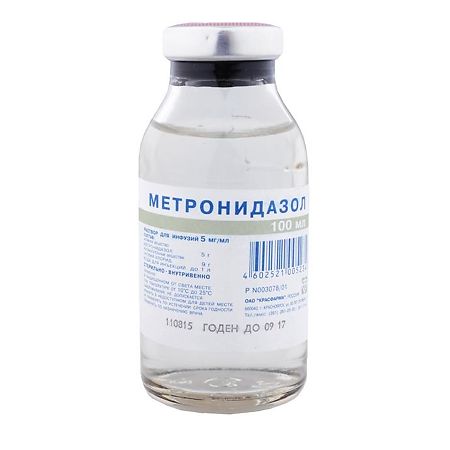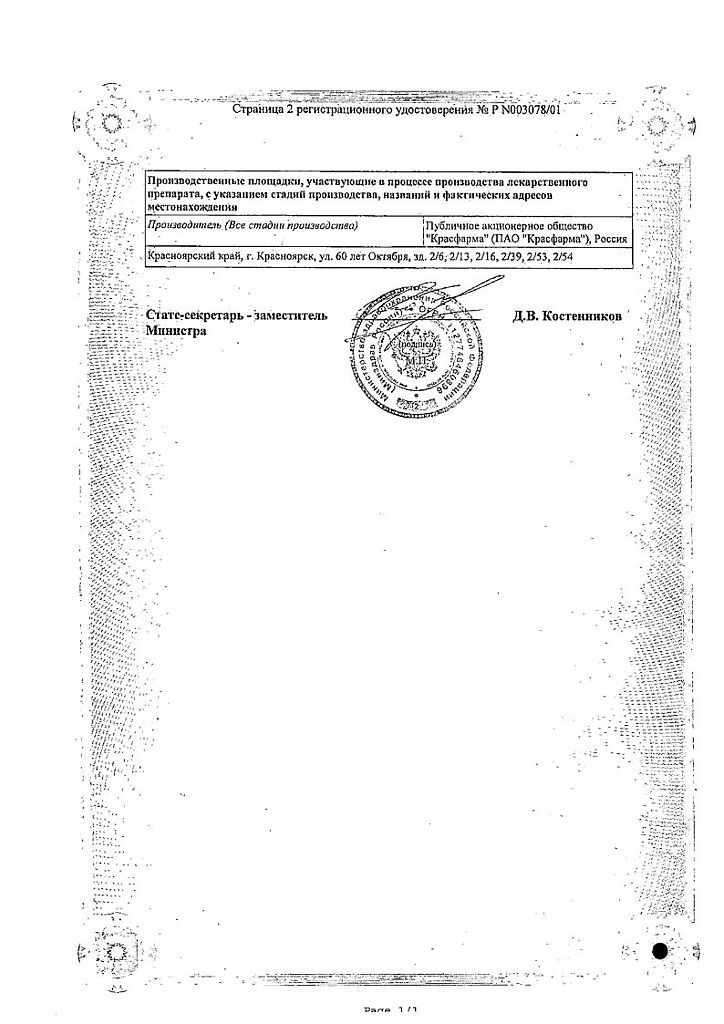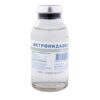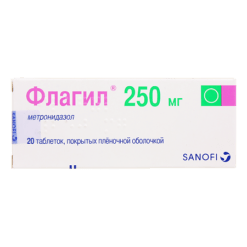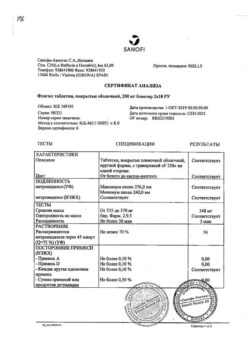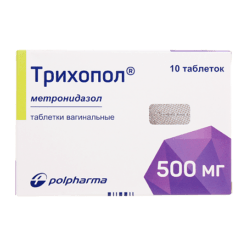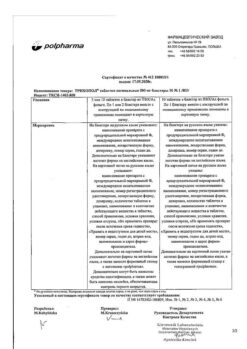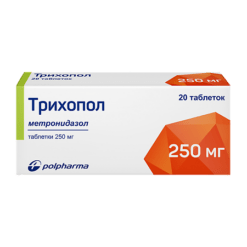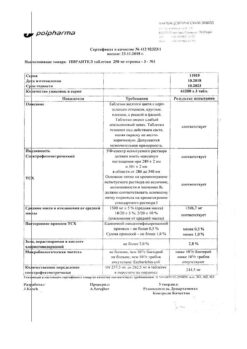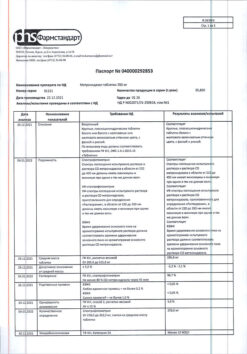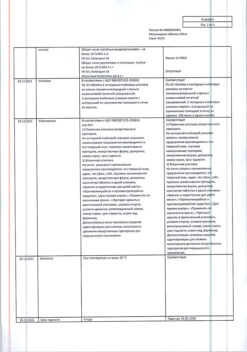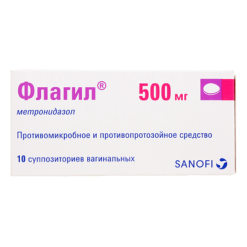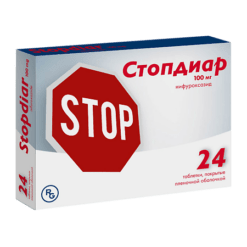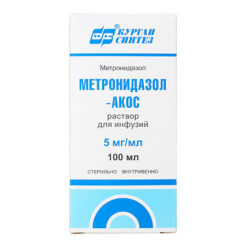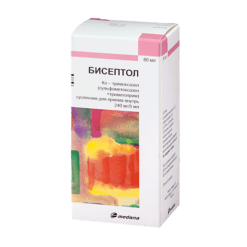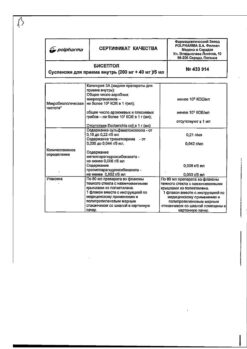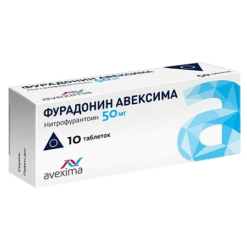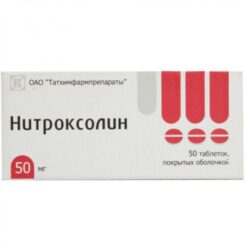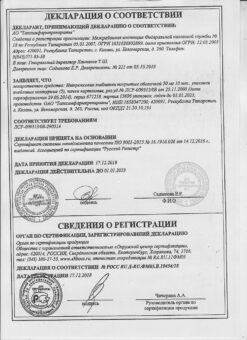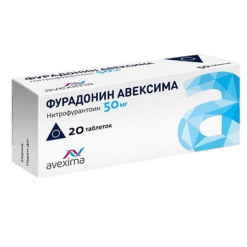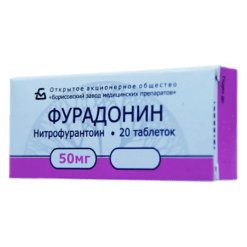No products in the cart.
Metronidazole, 5 mg/ml 100 ml
€1.00
Out of stock
(E-mail when Stock is available)
Description
An antiprotozoal and antimicrobial drug, a derivative of 5-nitroimidazole. Mechanism of action consists in biochemical reduction of 5-nitrogroup of intracellular transport proteins of anaerobic microorganisms and protozoa. The reduced 5-nitrogroup interacts with the DNA of the microbial cell, inhibiting the synthesis of their nucleic acids, which leads to the death of the bacteria.
It is active against Trichomonas vaginalis, Entamoeba histolytica as well as obligate anaerobes Bacteroides spp. (including Bacteroides fragilis, Bacteroides distasonis, Bacteroides ovatus, Bacteroides thetaiotaomicron, Bacteroides vulgatus), Fusobacterium spp, some gram-positive microorganisms (Eubacterium spp., Clostridium spp., Peptococcus niger, Peptostreptococcus spp.).
The minimum suppressive concentration for these strains is 0.125-6.25 µg/ml.
In combination with amoxicillin it shows activity against Helicobacter pylori (amoxicillin suppresses development of resistance to metronidazole).
Metronidazole is insensitive to aerobic microorganisms and facultative anaerobes, but in the presence of mixed flora (aerobes and anaerobes) metronidazole acts synergistically with antibiotics effective against common aerobes.
It increases the sensitivity of tumors to radiation, causes sensitization to alcohol (disulfiram-like action).
Indications
Indications
protozoal infections (extraintestinal amebiasis /including liver abscess/, intestinal amebiasis, trichomoniasis, balantidiasis, giardiasis (giardiasis), cutaneous leishmaniasis, trichomonas vaginitis, trichomonas urethritis);
infections caused by Bacteroides spp., incl. Bacteroides fragilis, Bacteroides distasonis, Bacteroides ovatus, Bacteroides thetaiotaomicron, Bacteroides vulgatus (bone and joint infections, central nervous system infections (including meningitis, brain abscess), bacterial endocarditis, pneumonia, empyema and lung abscess);
infections caused by Bacteroides spp. (including Bacteroides fragilis), Clostridium spp., Peptococcus spp., Peptostreptococcus spp. (infections of the abdominal cavity /peritonitis, liver abscess/, infections of the pelvic organs /endometritis, endomyometritis, abscess of the fallopian tubes and ovaries, infections of the vaginal vault after surgery/, infections of the skin and soft tissues);
sepsis caused by Bacteroides spp. (including Bacteroides fragilis) and Clostridium spp.;
pseudomembranous colitis (associated with the use of antibiotics);
gastritis or duodenal ulcer associated with Helicobacter pylori;
alcoholism;
as a radiosensitizing agent during radiation therapy (in cases where tumor resistance is due to hypoxia in tumor cells);
prevention of postoperative infections (especially after operations on the colon, peri-rectal area, appendectomy, gynecological interventions).
Pharmacological effect
Pharmacological effect
Antiprotozoal and antimicrobial drug, a derivative of 5-nitroimidazole. The mechanism of action is the biochemical reduction of the 5-nitro group of intracellular transport proteins of anaerobic microorganisms and protozoa. The reduced 5-nitro group interacts with the DNA of the microbial cell, inhibiting the synthesis of their nucleic acids, which leads to the death of bacteria.
Active against Trichomonas vaginalis, Entamoeba histolytica, as well as obligate anaerobes Bacteroides spp. (including Bacteroides fragilis, Bacteroides distasonis, Bacteroides ovatus, Bacteroides thetaiotaomicron, Bacteroides vulgatus), Fusobacterium spp., some gram-positive microorganisms (Eubacterium spp., Clostridium spp., Peptococcus niger, Peptostreptococcus spp.).
The minimum inhibitory concentration for these strains is 0.125-6.25 μg/ml.
In combination with amoxicillin, it is active against Helicobacter pylori (amoxicillin suppresses the development of resistance to metronidazole).
Aerobic microorganisms and facultative anaerobes are insensitive to metronidazole, but in the presence of mixed flora (aerobes and anaerobes), metronidazole acts synergistically with antibiotics effective against common aerobes.
Increases the sensitivity of tumors to radiation, causes sensitization to alcohol (disulfiram-like effect).
Special instructions
Special instructions
During the treatment period, ethanol intake is contraindicated (a disulfiram-like reaction may develop: cramping abdominal pain, nausea, vomiting, headache, sudden rush of blood to the face).
In combination with amoxicillin, it is not recommended for use in patients under 18 years of age.
With long-term therapy, it is necessary to monitor the blood picture. With leukopenia, the possibility of continuing treatment depends on the risk of developing an infectious process.
The appearance of ataxia, dizziness and any other deterioration in the neurological status of patients requires cessation of treatment.
May immobilize treponemes and lead to a false-positive Nelson test.
Colors urine dark.
When treating trichomonas vaginitis in women and trichomonas urethritis in men, it is necessary to abstain from sexual activity. Simultaneous treatment of sexual partners is mandatory. Treatment does not stop during menstruation. After treatment for trichomoniasis, control tests should be carried out during three consecutive cycles before and after menstruation.
After treatment of giardiasis, if symptoms persist, after 3-4 weeks, carry out 3 stool tests at intervals of several days (in some successfully treated patients, lactose intolerance caused by infestation may persist for several weeks or months, resembling the symptoms of giardiasis).
During the treatment period, it is recommended to stop breastfeeding.
Active ingredient
Active ingredient
Metronidazole
Composition
Composition
1 fl. metronidazole 5 mg
Excipients:
sodium chloride 900 mg,
sodium dihydrogen phosphate dihydrate (sodium phosphate monosubstituted 2-water) 300 mg,
d/i water (up to 100 ml).
Contraindications
Contraindications
leukopenia (including history);
impaired coordination of movements,
organic lesions of the central nervous system (including epilepsy);
liver failure (if prescribed in high doses);
I trimester of pregnancy;
lactation period;
hypersensitivity to the components of the drug;
hypersensitivity to nitroimidazole derivatives.
Use with caution in the second and third trimesters of pregnancy.
Side Effects
Side Effects
From the digestive system: nausea, vomiting, loss of appetite, intestinal colic, diarrhea, constipation, coated tongue, bitter, metallic taste in the mouth, stomatitis, dry mouth, glossitis, pancreatitis.
From the hematopoietic system: reversible neutropenia (leukopenia).
From the side of the central nervous system: peripheral neuropathy (feeling of numbness of the extremities), headaches, convulsions, drowsiness, dizziness, impaired coordination of movements, ataxia, confusion, depression, increased excitability, weakness, insomnia, hallucinations, irritability.
Allergic reactions: skin rash, urticaria, itching, erythema multiforme, angioedema and anaphylactic reaction, skin flushing, nasal congestion, fever, arthralgia.
Local reactions: thrombophlebitis is possible at the injection site (pain, hyperemia or swelling at the injection site).
From the hepatobiliary system: increased activity of liver enzymes, cholestasis, jaundice.
From the genitourinary system: dysuria, cystitis, polyuria. urinary incontinence, candidiasis of the vaginal mucosa, red-brown coloration of urine (causes a metabolite of metronidazole, has no clinical significance).
Other: increased body temperature, flattening of the T wave on the ECG.
Interaction
Interaction
When used simultaneously with antacids containing aluminum hydroxide and cholestyramine, the absorption of metronidazole from the gastrointestinal tract is slightly reduced.
With simultaneous use, metronidazole potentiates the effect of indirect anticoagulants.
When used simultaneously with disulfiram, the development of acute psychosis and impaired consciousness is possible.
An increase in the concentration of carbamazepine in the blood plasma and an increase in the risk of developing toxic effects cannot be excluded when used simultaneously with metronidazole.
When used simultaneously with lansoprazole, glossitis, stomatitis and/or the appearance of a dark color of the tongue are possible; with lithium carbonate – it is possible to increase the concentration of lithium in the blood plasma and develop symptoms of intoxication; with prednisone – the excretion of metronidazole from the body increases due to the acceleration of its metabolism in the liver under the influence of prednisone. The effectiveness of metronidazole may be reduced.
When used simultaneously with rifampicin, the clearance of metronidazole from the body increases; with phenytoin – a slight increase in the concentration of phenytoin in the blood plasma is possible; a case of toxic effects has been described.
When used simultaneously with phenobarbital, the excretion of metronidazole from the body significantly increases, apparently due to the acceleration of its metabolism in the liver under the influence of phenobarbital. The effectiveness of metronidazole may be reduced.
When used simultaneously with fluorouracil, the toxic effect, but not the effectiveness of fluorouracil, increases.
A case of the development of acute dystonia after taking a single dose of chloroquine in a patient receiving metronidazole is described.
When used simultaneously with cimetidine, inhibition of the metabolism of metronidazole in the liver is possible, which can lead to a slower elimination and increased concentration in the blood plasma.
With simultaneous use of ethanol in patients receiving metronidazole, disulfiram-like reactions may develop.
Overdose
Overdose
Symptoms: nausea, vomiting, ataxia; when taken as a radiosensitizing agent – convulsions, peripheral neuropathy.
Treatment: no specific antidote, symptomatic and supportive therapy.
Storage conditions
Storage conditions
In a place protected from light, at room temperature; do not freeze.
Keep out of the reach of children.
Shelf life
Shelf life
3 years.
Do not use after the expiration date stated on the package.
Manufacturer
Manufacturer
Kraspharma PJSC, Russia
Additional information
| Shelf life | 3 years. Do not use after the expiration date stated on the package. |
|---|---|
| Conditions of storage | In the dark place at room temperature; do not freeze. Keep out of reach of children. |
| Manufacturer | Kraspharma PJSC, Russia |
| Medication form | solution for infusion |
| Brand | Kraspharma PJSC |
Other forms…
Related products
Buy Metronidazole, 5 mg/ml 100 ml with delivery to USA, UK, Europe and over 120 other countries.

